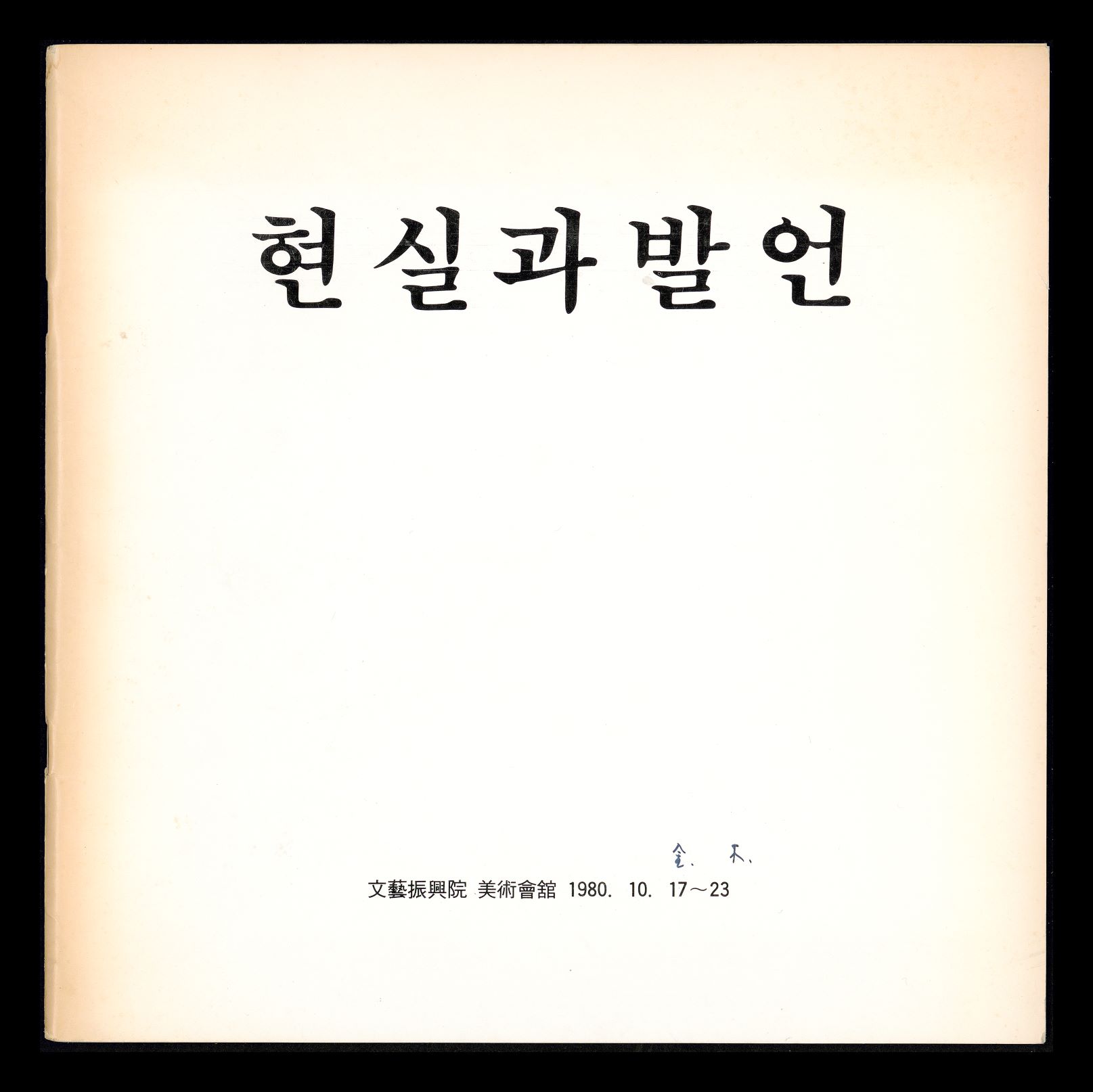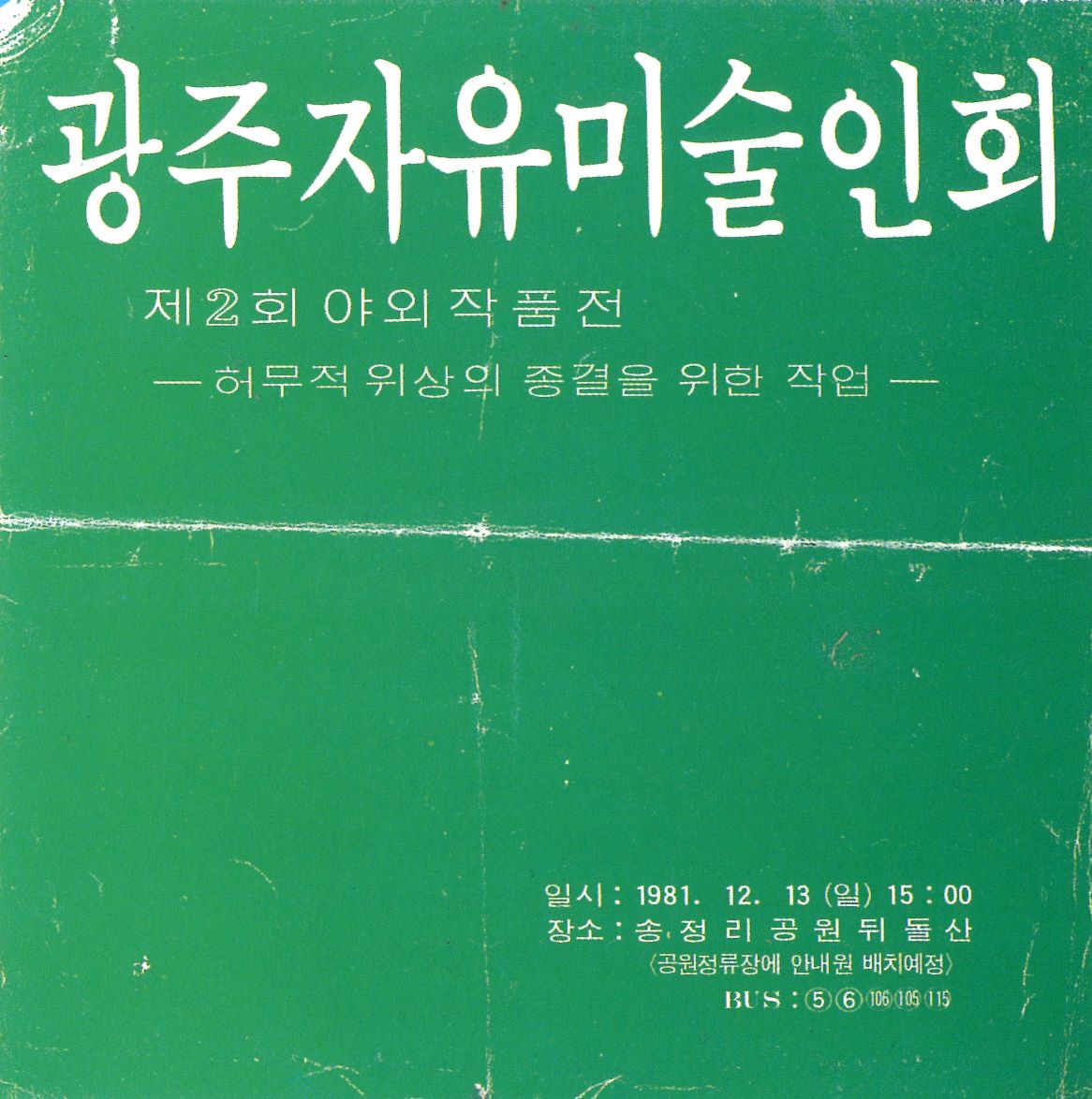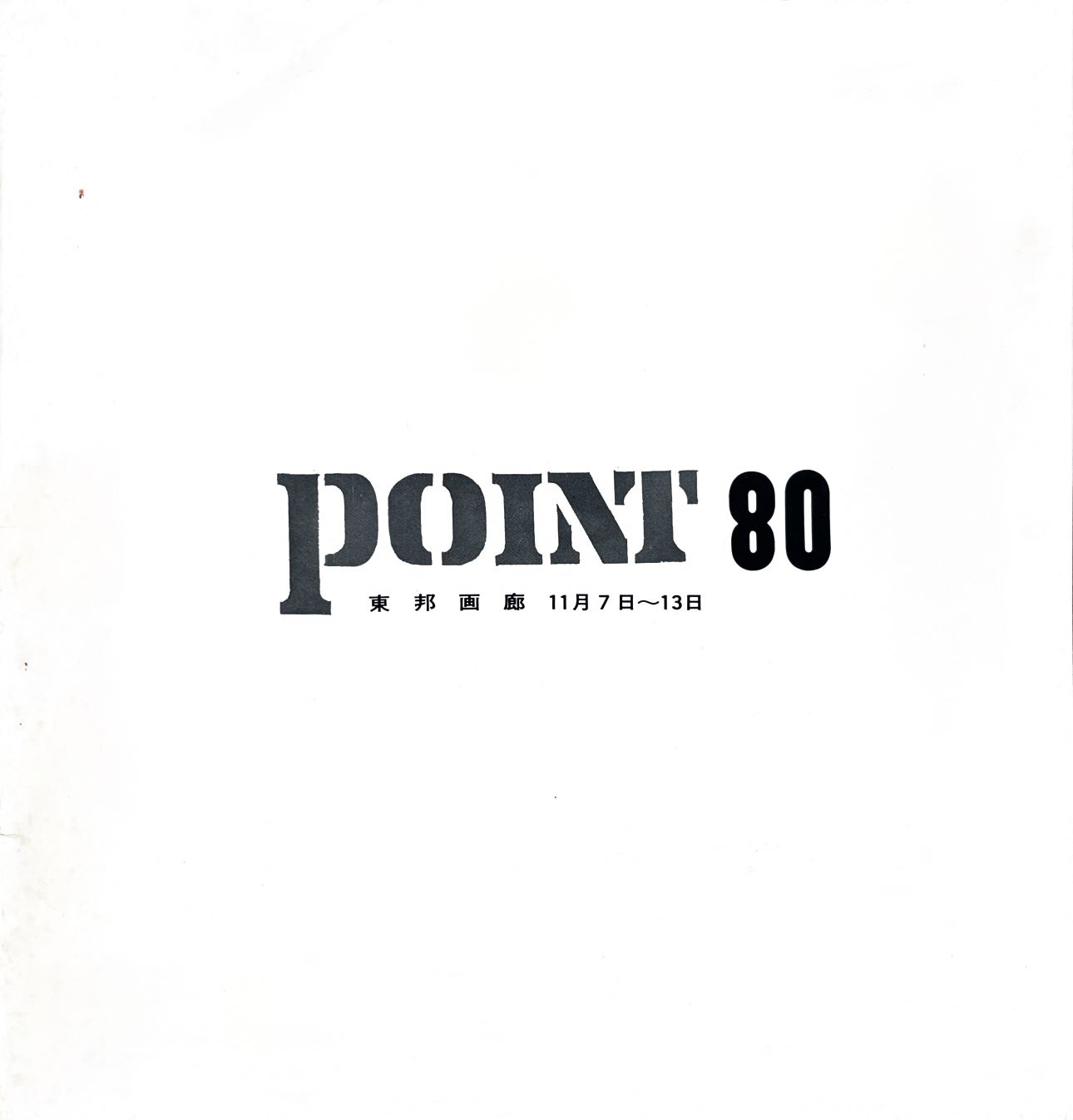
Reality and Utterance Inaugural Exhibition, Brochure, 1980. MMCA Art Research Center Collection, Gift of Kim Heedae
Reality and Utterance
* Source: Multilingual Glossary of Korean Art. Korea Arts Management Service
Related
-

Oh Yoon
Oh Yoon (1946-1986) is a sculptor, printmaker, and painter who participated in the Minjung art movement in the 1980s. He graduated from the Department of Sculpture at the College of Fine Arts, at Seoul National University. In 1969, while still a student at Seoul National University, he participated in the preparation of the inaugural exhibition of Reality Group [Hyeonsil dongin] with Kim Yoon-Soo, Kim Jiha, Oh Kyunghwan, and Lim Setaek, and began to explore the socially critical Minjung art movement. After graduating from university, he stayed in Gyeongju for two years to study traditional arts, such as stone Buddhist sculptures and terracotta figurines and set up a tile factory in Byeokje to start working with terracotta. The terracotta relief mural on the interior wall of the Guui-dong Branch of the Commercial Bank in Seoul and the terracotta relief mural on the exterior wall of the Dongdaemun Branch of the Commercial Bank are examples of his work from this period. In 1979, Oh Yoon participated as a founding member of Reality and Utterance [Hyeonsilgwa bareon] and continued to exhibit in the members’ exhibitions of Reality and Utterance, exhibiting socially engaged paintings, woodblock prints and banner paintings. His works evolved from his interest in the lives of laborers and peasants, and folk culture such as traditional performing arts and folktales. In the 1980s, he perfected his woodblock print style, focusing on portraits that exquisitely expressed condensed power and Korean sentiments of han (resentment) and sinmyeong (mirth). He created woodblock illustrations and covers for a number of publications, including Kim Jiha's Ojeok (Five thieves), and in 1986 he published a book of woodblock prints, Kal norae (song of sword). His representative works include the series Marketing, Dawn of Labor (1985), and the large banner painting, Great Desires for Unification (1985).
-

Korean Art Critics Association
Korean Art Critics Association is an organization founded by art critics in 1956. The founding members include; Choi Sunu, Lee Hangsung, Lee Kyungsung, Chung Kyu, Bang Geun-taek, Bae Gilgi, Chun Seung-bok, Kim Byungki, Kim Youngki, Kim Chung-up, and Kim Youngjoo. Lee Yil, a subsequent president of the group, established the quarterly art magazine Korean Journal of Art Criticism in 1986, and created the Korean Art Critics Association Award in 2009. Through this platform, the association continues to support artists and art writers.
-

Minjung Art
An artistic movement that came to prominence alongside Korea’s democratization movement in the 1980s. Minjung artists often sought to critically portray the violent repression and corruption of the military dictatorship, to represent the experiences of laborers and farmers, and to achieve social change through art. In contrast to abstraction, which constituted the mainstream of 1970s art in Korea, Minjung Art is notable for the use of representational and figurative forms. One possible point of origin for Minjung Art is Oh Yoon’s work in the Reality Group (Hyeonsil dongin). The group was formed in 1969 by Kim Ji-ha, Oh Yoon, and Lim Se-taek. A variety of Minjung art groups were established, including the Reality and Utterance (Hyunsilgwa bareon) in 1979 by Kim Jungheun, Oh Yoon, Joo Jae-hwan, art critic Sung Wan-kyung, and Choi Min, the Gwangju Freedom Artist Association (Gwangju jayu misulin hyeopuihoe) in 1979 by Hong Sungdam and Choi Youl, the Imsulnyeon (The Year Imsul) in 1982, and the Dureong in 1983. These groups all commonly critiqued Western capitalism. In terms of form, Minjung artists adopted traditional and ethnic folk modes of expression using diverse media such as collage, printmaking, oil painting, and photography. Following the 15 Years of Korean Minjoong Arts: 1980-1994 Exhibition at the National Museum of Modern and Contemporary Art, Minjung Art became an accepted part of Korean art history. Overseas, Minjung Art has also become a recognized term that describes this genre and its unique focus on the political and social history of Korea.
Find More
-

Realism
In Korea, realism was used as a critical term as well as artistic methodology. It referred to different meanings according to the three phases seen between the 1960s and the 1980s: a departure from the basic proposition “art is a reflection of reality,” raised by the Reality Group (Hyeonsil dongin) in the late 1960s; a mid-stage influenced by the artistic theory which emphasized the formal pursuit of realism within Minjung-oriented works in the 1970s; and a final stage referring to the work created within the fully fledged Minjung Art movement of the 1980s. In this context, “critical realism” refers to an artistic method executed by Korean progressive artists as well as an associated critical assessment of the ideological traditions of aestheticism and formalism. It is represented through figurative artworks that reflect a critical view of early 1980s life, to recover the power of the art as tool to portray and effect reality. Art groups, such as Reality and Utterance (Hyunsilgwa bareon) or the Gwangju Freedom Artist Association (Gwangju jayu misulin hyeopuihoe) produced numerous examples of such critical realism. In distinction, “Minjung realism” refers to an art trend that developed in the mid-1980s which sought to relocate the creation and reception of art in a broader context beyond critical realism, by combining the dynamics of cultural movements with a new artistic method. Artworks of Dureong and Citizen’s Art Schools, and the banner paintings depicting the scenes of the June Democratic Uprising and the July-August Great Labor Uprising in 1987 are all considered as examples of Minjung realism. The term “factional realism” (coined by Shim Kwanghyun) refers to an art approach which attempts to combine critical realism and people’s realism to create a scientific method for politically effective art by eliminating any formally or conceptually indeterminate aspects of the work. Finally, “progressive realism” (as proposed by Lee Youngchul) refers to a multifaceted approach to solving the diverse issues of political saliency in art and the structures and strategies of activism. All these realisms were influential within the production of Minjung Art between the late 1980s and the early 1990s.
-

Gwangju Freedom Artists Association
An art organization established in Gwangju and related to the early 1980s Minjung art movement. The Minjung art movement fought for art based on real life, in critique of the government-controlled art system and the art for art’s sake movement in the 1970s. The Gwangju Freedom Artists Association emphasized “art from the bottom”, art that can be created by public collaboration and appropriation, not by elites or art professionals. In September 1979, Hong Sungdam, Choi Youl, Kim Sanha, Lee Youngchae, Kim Yongchae, and Kang Daegyu prepared an exhibition. They later participated in the Gwangju Uprising in May 1980. They performed a shamanic ritual for cleansing a dead person's soul in the Nampyung Deudeulgang River in 1980, and also hosted outdoor exhibitions that commemorated the Gwangju Uprising in Songjeong-li, Gwangju in December 1981. The association opened the Citizens Art School in 1983 and engaged in a site-based art movement. The public print movement was expanded to Seoul, Seongnam, Incheon, Mokpo, and Iksan. In December 1985, its name was changed to the Visual Media Center. Their activities contributed to the foundation of the National Art Association (Minjok misul hyeopuihoe) in 1985.
-

Point
POINT was the first small Minjung art collective active in Suwon from 1979 to 1985. It was founded by holding the exhibition POINT-79 of Baek Jonggwang, Chang Younggook, and Choi Choonil in December 1979 at the third-floor exhibition hall of Croba Department Store. In its second exhibition in 1980, Lee Ukbae and Park Chaneung also participated. The third exhibition was joined by Kang Moonsoo and Moon Seokbae, and the fourth, Jeong Gilsu. Being university students at the time, the members of POINT criticized Gyeonggi Young Artists’ Association [Gyeonggi cheongnyeon jakgahoe] for focusing on regular exhibitions without a distinct theme and pursued social art activities. Upon becoming more conscious of social activism after the inaugural exhibition, they realized that the name “POINT” was a foreign word and failed to reflect their aesthetic orientation. Thus, in May 1984 they renamed their collective Locus and Focus [sijeom·sijeom]. It means that they see through the “here and now” of the times in which they live with the eyes of art. Through various forms of expressions, such as painting, sculpture, and printmaking, they addressed a wide range of topics, including the relationship between existential elements and society, marginalized lives, social satire, and the critical minds of individuals. Moreover, through the aforementioned meaning of sijeom, they contemplated on their awareness of contemporary art and questioned their own perspectives. The following passages from their manifesto provide a glimpse into the aesthetic attitude they assumed. First, Locus and Focus asks how they should view the time in which they live while being freed from the pursuit of Western art. Second, its members as human beings and as artists propose an aesthetic of the most ordinary and simplest possibilities for the horizon of the times. Third, in order to do so, they should ask themselves direct questions about social reality. The regular exhibition Locus and Focus 85: In the Midst of a Crowd that was curated in February 1985 traveled across Gyeonggi-do Province. It was held in the cities of Suwon, Anyang, and Bucheon. Locus and Focus attempted to build its own regionality through this traveling exhibition, but it was disbanded after the exhibition circuit because the activities of its members became fragmented in and after 1985. Later, some of the members led the woodcut movement by forming Woodblock Print Pan [Mokpan moim pan] led by Choi Choonil, the Artist Group Dawn [Misul dongin sawbyeok] in Suwon. Also, Lee Ukbae and Park Chaneung moved to Anyang founded Woorigeurim.






